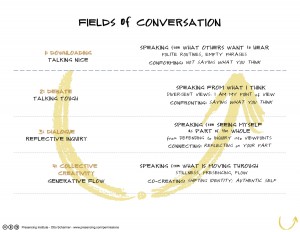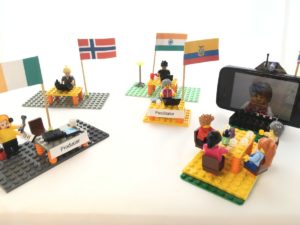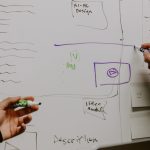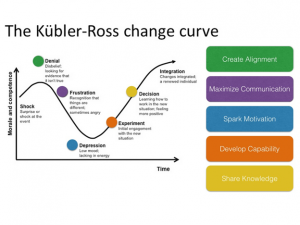Tag Archives: participation
Feb
Design principles for humane hybrid events
Hybrid gatherings have been happening for years, from the team meeting where we arrive and hear that ‘Mary is going to dial in’, to a company wide ‘all hands’ meeting where national teams convene in conference rooms around the globe. Many organisations are starting to plan for hybrid gatherings in anticipation of at least partial lifting of lockdown.
Many facilitators, myself included, when approached to design a hybrid event, start with ‘are you *really* sure you want one?’! A hybrid event is effectively three events comprising: the people co-located in a physical space (the ‘Roomies’), the people who are joining by phone or virtual meeting platform (the Zoomies), and the meeting where you are trying to link all of these participants together: the Full Catastrophe, as Zorba the Greek might call it.
I have spent lots of time trying to map the variations of hybrid meetings using pods and nodes and network diagrams, but I realised that was a little like planning to bake a cake and only thinking about the receptacle – round tin or square tin or muffin tins or even paper bun cases – rather than focusing on whether I wanted a lemon drizzle cake, or banana bread or [insert your favourite lockdown treat here!]. I want my cake to be tasty and perhaps even a bit healthy, and I’ll probably manage to make it roughly the right flavour and texture, regardless of the kind of tin I use. Similarly, I want to help people achieve their aims for an event, regardless of the technical configuration of wires and pods and nodes. ‘Hybridity’ is the means rather than the end. We don’t set out to have a ‘hybrid’ meeting, we set out to bring people together to achieve something.
So, let’s leave aside the different containers and configurations and logistics to focus on what’s really important. There are two crucial elements particular to hybrid gatherings which, if we get them right, will help people do the work they have convened to do, and help them to actually thrive doing it. I’ve called these two elements ‘coherence’ and ‘connection’.
‘Coherence’ is the extent to which everyone can contribute to and receive all parts of the event. This particularly refers to having access to other participants’ (verbal or written) contributions (as distinct from just the input of keynote speakers or panels). Literally and metaphorically, it means everyone being ‘on the same page’, even as that page fills up with questions, ideas, insights and other contributions from participants. It enables people to feel heard, whether that is in writing, or verbally.
Coherence is an aspect of events that we can take for granted when we are all co-located in either virtual or physical space but it requires really careful design when people are working in different spaces. Different media and tools become vital, for example flip charts, ‘stickies’, virtual whiteboards, or shared electronic documents.
As a simple example, in a workshop with GlobaltFokus, where the trainer and producer were remote and the participants were co-located, participants photographed the flip charts they generated in their small group work and uploaded them to the (virtual) meeting platform we were using. This enabled the trainer and all the other participants to see each group’s material projected on a screen, and discuss them during plenary.
Connection is the extent to which everyone in the room has an opportunity for some meaningful human interaction. That can be obtained from interacting with others in general, but it becomes a more compelling and richer experience when it occurs with a more intimate pair or small group (up to 5). This kind of connection often starts to happen naturally at face to face events, over coffee, while we’re waiting to start, and during breaks. We’re all getting much better at building it into virtual events, using a range of tasks and tools to enable people to have conversations in smaller groups, with breakouts being the best example. But once we move into hybrid events, it is all too easy, particularly in relation to social time, to let the ‘Roomies’ do their own social thing, and leave the remote ‘Zoomies’ to step away by themselves. This has the effect of creating two diverging meetings – the virtual one and the face to face one, and it particularly disadvantages the remote participants. Of course, remote participants may be able to get light relief, stimulation and empathy from others in their immediate location (though not even that at the moment, where so many of us are working in solitary home offices), but putting real thought and effort into helping everyone build some familiarity, empathy and understanding with at least some other participants will help to increase engagement at the event and commitment to the outcomes, and will create an experience of inclusion, of really mattering. All of these make it easier to keep people present and involved, to identify and address dissent and resolve conflict, to sow the seeds for consensus, and crucially, to support participants towards collective action.
In an event we facilitated recently, with 11 co-located participants and two remote participants, we used a separate, lighthearted messaging channel where photographs and snippets were shared among all event participants, whether co-located or remote. This simple addition helped to give the Zoomies a sense of being remembered and included, and helped to remind the Roomies that there were important voices outside the main room.
There’s plenty more to talk about in relation to how to do all of this, and I’ll save that for my next post, but let’s cut to the chase cake: participatory, engaging and productive hybrid events can be delivered by using the concepts of coherence and connection to design a unified – and unifying – event for all participants.
Comments Off on Design principles for humane hybrid events
Tagged | collaboration, facilitation, hybrid, leadership, meetings, participation, remote teams, teamwork, virtual facilitation, virtual meetings, virtual workshops
Jul
10 post-referendum coping strategies
By coincidence, a couple of weeks ago, I was researching the concept of “othering” – “to view or treat (a person or group of people) as intrinsically different from and alien to oneself”. The evolution of this concept can be traced through a number of philosophers, sociologists and pyschologists, from Hegel, through De Beauvoir, and on through Lacan, Levi-Strauss, Said, Rorty….and a search for “referendum” and “othering” shows a surge in its use. I had only been delving into the term as part of my reaction to a film, and it’s dismaying that it has become so acutely relevant so suddenly: I’ve found myself using it several times a day during the past week.
My Framework colleague Gopal shared some thoughts with us on his reactionto B***xit and this catalysed some of my own thinking on how to move beyond “othering” and create some sort of functioning vision for the future. Many models of change and shock (e.g. the Kubler Ross change model – thanks, Gopal), and Otto Sharmer’s Theory U emphasise the importance of taking time to reflect and conduct ‘deep listening’, and then moving on to experimentation.
 It’s been interesting to notice, among all the noise, some really tangible initiatives around – ideas, experimentation, prototyping and implementation, all with the goal of building community cohesion and resilience, and ensuring that voices are heard from all parts of society. Some of these are a resurgence of interest in tools and techniques which have existed for many years; others are very new. The themes which seem to be emerging are, firstly, how to have meaningful conversations characterised by empathic listening across a gulf such as the one which has opened between ‘Remain’ and ‘Leave’ and secondly, how to turn those conversations into a form of democracy, widening the term beyond ‘representational democracy’, to participative and deliberative democracy? Here are a few initiatives which caught my eye:
It’s been interesting to notice, among all the noise, some really tangible initiatives around – ideas, experimentation, prototyping and implementation, all with the goal of building community cohesion and resilience, and ensuring that voices are heard from all parts of society. Some of these are a resurgence of interest in tools and techniques which have existed for many years; others are very new. The themes which seem to be emerging are, firstly, how to have meaningful conversations characterised by empathic listening across a gulf such as the one which has opened between ‘Remain’ and ‘Leave’ and secondly, how to turn those conversations into a form of democracy, widening the term beyond ‘representational democracy’, to participative and deliberative democracy? Here are a few initiatives which caught my eye:
1. The Kumi method for conflict transformation, in which some of my ICA:UK colleagues collaborated
2. Compassionate Listening engages participants in processes that “have each side seeing the humanity of the other, even when they disagree”. This approach was developed for peacebuilding in areas of acute conflict, but it now feels very relevant closer to ‘home’ (whatever ‘home’ means these days)
3. I hadn’t heard of Neighbourhood Plans before now, but they have statutory status, are developed by a group of citizens, and are concerned with local issues such as housing, transport, amenities. They have to be considered by the local authority (the legislation was introduced in 2011) and so they are a forum which goes beyond passive ‘consultation’ to more active co-creation. Some low tech tools for planning are available here
4. In Spain, Podemos have been particularly active in involving citizens in the development and running of their movement, using both face to face and online collaboration tools. The latter include using Agora Voting to shortlist their MEP candidates and using Appgree and Loomio for idea testing and decision making (Podemos have also been involved in piloting D-Cent, below)
5. The RSA launch the Citizens Economic Council next week. This is a project examining the connection between lay economic thinking and economic policy by enabling citizens to deliberate and make recommendations on future economic priorities.
6. So say Scotland is an online hub for innovation around democracy in Scotland. They use story telling, game playing, and citizens assemblies to “broaden participative and deliberative democracy as a compliment to and an evolution of representative democracy”, inspired by Iceland’s ‘Anthill’ assembly in 2009. It seems to have gone little quiet at the moment on the web, though the Facebook page is active
7. Nesta have funded D-CENT (Decentralised Citizens Engagement Technologies), which is a platform and a set of tools to enable citizen engagement. Pilots will run with existing user communities to gather knowledge and test the platform, but the system is open to movements anywhere starting to test and use the software. It is being piloted in Spain, Iceland, and Finland by organisations such as the 15M citizen movement, Citizens Foundation, Better Reykjavik and Better Iceland, and Open Ministry, a crowdsourcing site linked to the Finnish parliament. Whoops, this is a European project – what will happen to projects like these now?
8. Crowdpac, in addition to providing very detailed ‘ideological mapping’ of political candidates to make it easier to decide how to vote, also provides ‘micro delibration’ for the individual to help them work out where they actually stand, before casting their vote. This helps us to move beyond personality politics and make more informed decisions (the intention is that Crowdpac will also work to create more diversity among candidates for political office by facilitating crowdfunding for campaigns).
9. Participatory budgeting is gaining traction. Scotland’s ahead of the game here too (this post was *not* written by our Scottish Frameworker, honest!). The aim of participatory budgeting is to “address inequalities in service provision and resource allocation, engage and empower citizens in discussions on public budgets and stimulate co-production and mutual responsibility between citizens and the state”.
9.5 I confess I was stuck for #10 so I turned to one of my favourite blogs, From Poverty to Power, to see whether there might be a glimmer of light. There I found an interesting analysis of the implications of the referendum for development and aid, and a wonderful neologism, “straw clutchism”, which may be what I’m doing!
10. And then, just as I was going to post with 9½ thoughts, I received a message via one of my ICA:UK colleagues. Involve, the thinktank and charity specialising in public participation with a mission to “deepen democracy”, have issued a shout out for facilitators to “explore the different ways that we might work together to make the post-referendum debate more productive; and to provide a space for people with facilitation and engagement skills to learn more about each other and spark productive partnerships”. The mooted date for a first meeting is 22nd July.
Maybe something can be built from the ashes?
Comments Off on 10 post-referendum coping strategies
Tagged | consultation, deliberative, participation, participatory
Mar
Learn to facilitate fantastic virtual meetings and workshops
The revolution in remote working and virtual meetings has taken hold, but our skills haven’t necessarily kept up.
Learn to run excellent virtual meetings and workshops. ICA USA and ICA UK have been in existence for over 50 years, teaching people how to maximise engagement and participation in the voluntary and NGO sector.
Now our skills have been applied to remote facilitation.
Over 8 weeks (approximately 1.5 hours a week plus ‘homeplay’), you will:
- Gain competency leading virtual meetings with Adobe Connect, and ToP Focused Conversation.
- Build your confidence as a virtual facilitator.
- Learn tools and techniques for eliciting participation, virtual meeting design, and best practices for smooth and engaging facilitation.
No special skills or equipment needed apart from a computer with an internet connection, and a headset.
Sign up here for the next course, which starts on 5th April 2016 at 4pm BST or contact Orla Cronin for further information
Comments Off on Learn to facilitate fantastic virtual meetings and workshops
Tagged | facilitation, participation, participatory, technology, training
Feb
New tools and resources available via Framework
To celebrate Framework’s 30th birthday, we have trawled through our filing cabinets and uploaded some of our favourite tools and reports to the the resources page. Come and see us at Stand 12 at the Bond Conference on 29/2-1/3/2016 to discuss them with us (Orla will be there with her Framework hat on on Tuesday)
Feel free to use these resources, including sharing them and modifying for non-commercial purposes. A credit would be appreciated!
Tools for working in organisations which we’ve recently uploaded include:
Capacity building methods overview
Capacity building programme matrix
Monitoring & evaluating capacity building: A practical tool
Impact grid exercises to explore organisational change
Comments Off on New tools and resources available via Framework
Tagged | capacity building, evaluation, participation
Jan
Free group and teamwork training for active citizenship
FREE Open College Network accredited training for voluntary organisations involved in youth & community work in the North West. The 1 day training is provided by ICA:UK and covers group and teamwork skills for supporting active citizenship. This funding expires in February. If you can convene a group of 10, contact amelia@ica-uk.org.uk by 5pm on Weds 2nd February 2011 to establish whether you qualify.
Comments Off on Free group and teamwork training for active citizenship
Tagged | participation, training
Jan
OCR presenting at ICA:UK Annual Conference
We’ll be presenting a brief overview of our ‘Partners in Politics’ evaluation at the ICA:UK conference “Building strong communities through participation”. Bookings for the conference are still being accepted via the ICA:UK website.
Comments Off on OCR presenting at ICA:UK Annual Conference
Tagged | evaluation, participation






